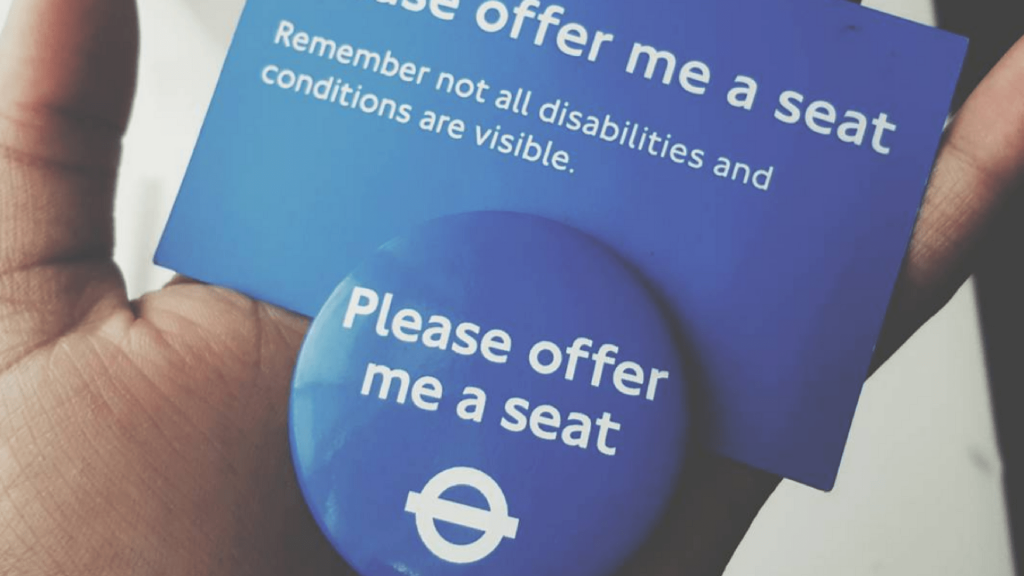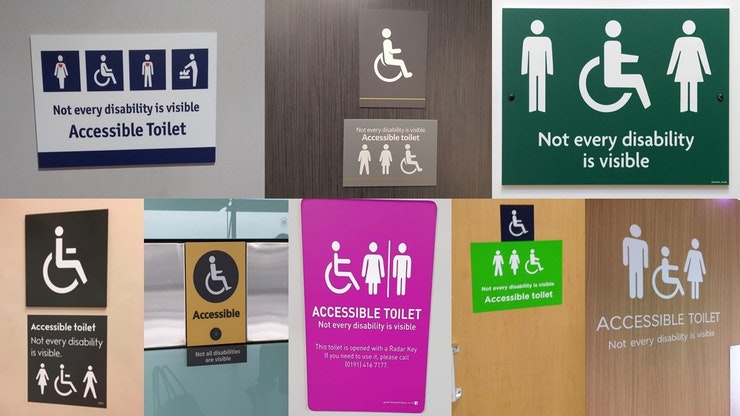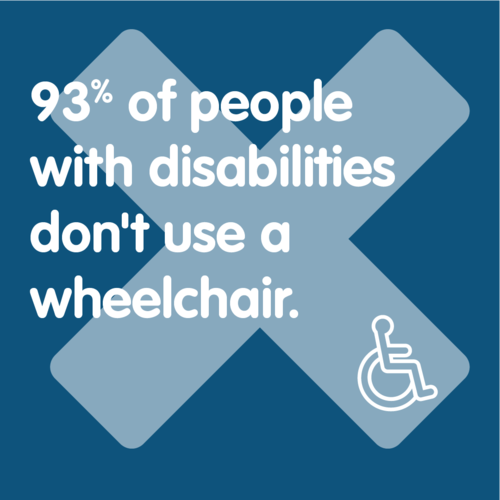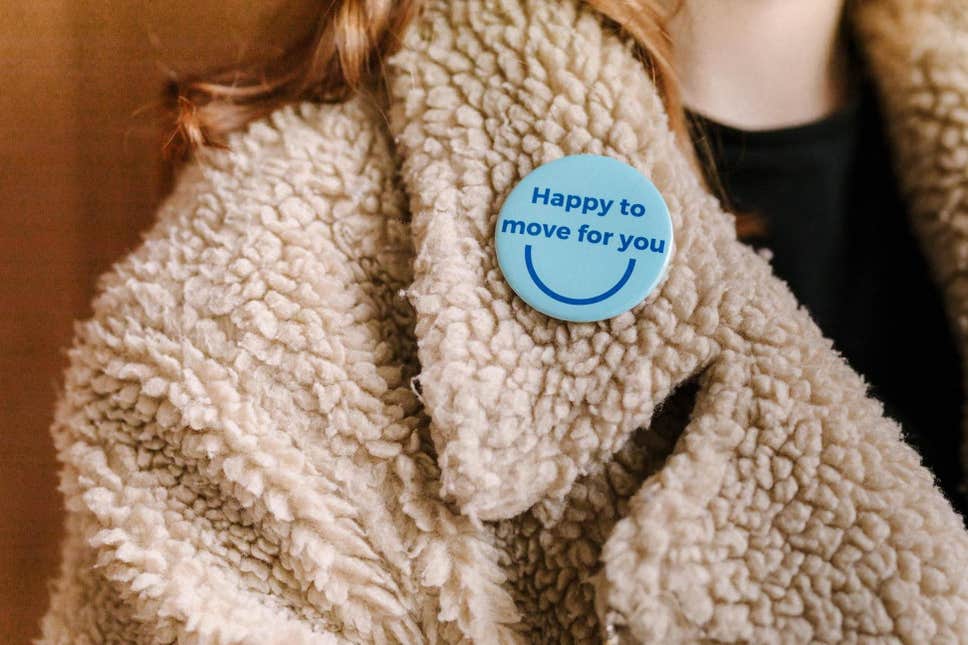
What is an invisible disability?
The Invisible Disabilities Association says:
An invisible disability is a physical, mental or neurological condition that is not visible from the outside, yet can limit or challenge a person’s movements, senses, or activities.
Symptoms can be debilitating pain, fatigue, dizziness, cognitive dysfunctions, learning differences, mental health disorders, or hearing and vision impairments for example. They can limits your daily activities.
These can come from a wide range of conditions like Fibromyalgia, Crohn’s disease, Multiple Sclerosis (M.S.), Autism, Anxiety, Myalgic Encephalomyelitis (M.E. also known as Chronic Fatigue Syndrome), Lupus, and many more…
93% of disabled people don’t use a wheelchair
In the UK, 93–95% of disabled people are not wheelchair users. The Visability 93 project wants to change the wheelchair symbol so that it is inclusive of all disabilities, visible or invisible. They hope that as a result, more people would be able to access the services they need, without being questioned.
The spoon theory
When you live with a chronic disease, your energy is limited. You will have bad days and good days. You need to pace yourself and plan ahead what you will be able to do that day. The Spoon Theory was created by Christine Miserandino to explain to a friend how it felt to live with Lupus, making one spoon an energy unit: If you are healthy, you start your day with an unlimited number of spoons, but if you’re not, you might start your day with 15 spoons on a ‘good day’. Everything you do will take away some spoons, and when they are gone, you can’t do anything until the next day.
Public places: Priority seats in transports, accessible toilets and disabled parking spaces
It’s easy to find articles about people with invisible disabilities being treated badly by the public assuming they are abusing the system.
“I have been verbally abused on public transport because I have a white cane & use my phone. I have residual vision like 94% of registered blind people. I use accessible tech to magnify the screen.#BlindPeopleUsePhone”
— Dr Amy Kavanagh
Some initiatives are trying to help
Blue Badge
The Blue Badge scheme has been extended to invisible disabilities, including autism and mental health conditions.
In the transports
Transport for London created a badge and a card stating “Please offer me a seat”. You don’t have to prove you need it. It can empower some people to ask for a seat and if you’re lucky, someone might notice it and you might not even have to ask. But a lot of people using it seem to still feel judged or get weird looks.
“I’ve only used it a few times, when I have, I can just feel people staring at me, I’ve never used it when the trains have been particularly busy so couldn’t say whether it actually works or not, but I’ve never felt more judged.”
— Caitlin

‘Happy to move for you’ is the same idea but for people who are happy to offer their seat to someone who might need it. I really like this one. Ellie Kime came up with this badge:
Or the initiative from the Heathrow airport and their green lanyards with sunflowers. Again you don’t have to prove you need it.
Toilets access
Crohn’s & Colitis UK has launched Not Every Disability is Visible inspired by campaigner Grace Warnock. They ask UK’s major supermarkets, restaurants, pubs and travel hubs to change their accessible toilet signs to highlight that Not Every Disability is Visible.

You can get involved, they provide material on their website.
At work
I know a few people who had tried at their work place to get disabled colleagues to do some usability testing for them. They had sent an email to everyone, requesting volunteers. Even though they knew from HR that there are actually disabled people, they had no answer.
Maybe people didn’t read the email, or were not interested. But because it seems to happen quite often, my assumption is that most people don’t want others at work to know they have a disability. Or to be observed by colleagues while struggling doing a task. Or fear they will have to explain their conditions and maybe get defined by them afterward.
The expectation that everyone wants to get fit or lose weight
At work, there are often lot of initiatives for employees to get fit or lose weight. How do you go about turning these down, when you don’t want to disclose that you have an issue preventing you to take part?

We should have walking meetings!
A quick Google search for “walking meetings” will return lots of articles about how great they are, but none on the first page seems to take into account that some people in your team might not be able to do this.
By presenting this like a great idea, with most in the team jumping in, others might find themselves in a position where they feel they have to explain themselves if they don’t want or can’t take part.
“I’d rather be thought rude than detail to a colleague why I’m not folding chairs and stacking them against the wall at the end of the meeting.”
— Hope R. Henderson
We should always be mindful that we’re all different and offer alternative or a way out.
More information about running accessible meetings and events in this Medium article, by Sheri Byrne-Haber.
As a person with inivisible disabilities, is it your responsibility to educate others?
Some people with disabilities (visible or invisible) are happy to talk about it openly. But they can get tired of explaining again and again.
There is also quite a difference between educating family, friends, colleagues compared to complete strangers in the public transports or on the way to the toilets!
“Unfortunately, people often judge others by what they see and conclude a person can or cannot do something by the way they look. This attitude can be equally frustrating for those who may appear unable but are perfectly capable, as well as those who seem able, but are not.”
— IDA website
Social media can help spread the word and raise awareness. Having more representations of these disabilities and the impact on people’s daily life in the media, TV, and films would also make a difference.
We need to spread the message that you can look OK but might actually be struggling or look weird but just trying to cope being in a stressful environment, look drunk but just be dealing with neurological problems.
Don’t assume. Keep an open mind.
So, should you have to ‘come out’ as disabled when you have an invisible disability?
No. Of course not.
“Knowing someone has a disability more often than not changes the way you perceive them. Whether the reaction is discriminatory or empathetic, this unwanted attention can make life feel suffocating. In being open about our disability, we unfortunately have to accept the reality that people will treat us differently.”
— Isabelle Jani-Friend
A short answer in this article:
Coming Out as a Person With an Invisible Disability – by Hope R. Henderson
“Most days, most places, I don’t want to tell. I don’t want to tell the driver or the scowling elderly passengers why I need a seat on the bus. I don’t want to explain that I’m not there to teach the yoga for disabilities class. ”
— Hope R. Henderson
A longer answer here :
Coming Out As…Disabled – By Victoria A. Brownworth
“So why am I so concerned about keeping my disability as hidden as possible, when so many people share disability? The primary reasons are similar to those for staying in the queer closet: protecting employment, worrying about how people will treat you if they know, fear of losing friends, fear of isolation, fear of being seen as damaged, fear of being pitied.”
— Victoria A. Brownworth
Another article worth reading is the experience of Alison Stine who was born with less than 50% hearing due to a congenital issue:
You talk real good – Alison Stine
“I pass as hearing. I don’t wear hearing aids, but even if I did, they would be hidden by my hair. I’m a younger, ‘healthy-looking’ person — not the image that is conjured up when most people think of the hard of hearing…”
“…Because I pass, I am part of no group, without a clear identity or sense of belonging…”
“…When I do disclose my difference, I try to make it casual. I start with ‘It’s not a big deal …’ Still I watch abled people’s faces fall, time and again. A disabled or different person has entered their space — interrupted their life of not paying attention, not considering, or maybe not even caring — and suddenly everything has been upended…”
— Alison Stine
But if you feel like disclosing your disability will help you, then go for it:
And if you want to read about my invisible disability, it’s here: An invisible side of M.E.
More on the subject
Work and disability – NHS
How do you define invisible disability? | invisible disability definition – Invisibiledisabilities.org
New blue badge rules to benefit people with hidden disabilities – the Guardian
Notes
This post was prompted by a call for lightning talks ideas from the A11Y Scotland conference’s organisers.I’ve done a write up here.



